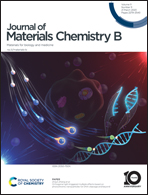Photo-activated autophagy-associated tumour cell death by lysosome impairment based on manganese-doped graphene quantum dots†
Abstract
Autophagy is indispensable in normal cellular processes, yet detrimental to cancer treatment because it severely lowers the therapeutic efficiency. One of the keys to solve this problem may lie in lysosomes, which requires the rational design of nanomedicine that is capable of localizing and maintaining its efficacy in lysosomes. In this work, a facile and versatile nanoplatform based on manganese-doped graphene quantum dots (Mn-FGQDs) is developed for effective and precise photodynamic impairment of lysosomes. Specifically, the incorporation of Mn not only strengthens the generation capability of reactive oxygen species (ROS), but also facilitates its accumulation in lysosomes. Moreover, Mn-FGQDs are structurally robust and retain their high photodynamic efficiency in the lysosomal environment. On this basis, the light-triggered generation of ROS would primarily influence the function of lysosomes, leading to lysosome impairment and thereby effectively blocking the protective autophagy recycling. More impressively, a continuous increase in the oxidative stress level in lysosomes causes severe autophagy dysfunction, as revealed from an abnormal increase in autophagosomes and autolysosomes. This eventually results in autophagy-associated cancer cell death accompanied by the characteristics of apoptosis and ferroptosis. Overall, the present work paves a new way for cancer therapy via precise lysosome impairment induced autophagy dysfunction.



 Please wait while we load your content...
Please wait while we load your content...